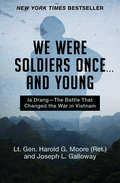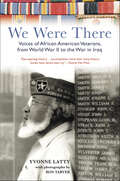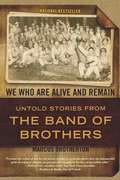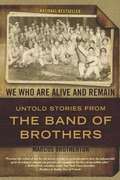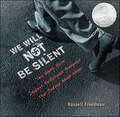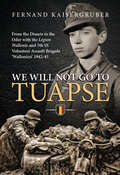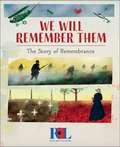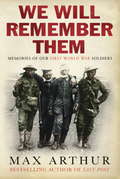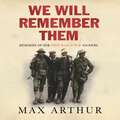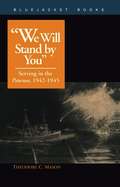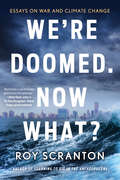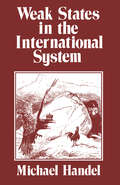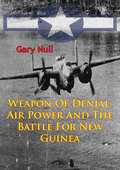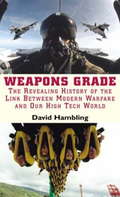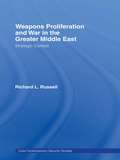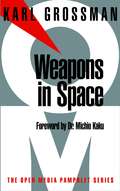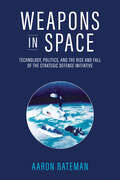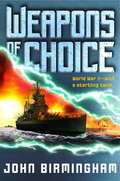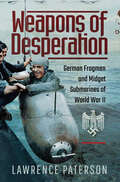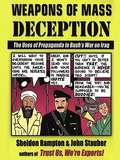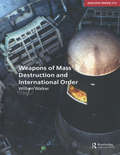- Table View
- List View
We Were Soldiers Once . . . and Young: Ia Drang—The Battle That Changed the War in Vietnam
by Harold G. Moore Joseph L. GallowayThe New York Times bestseller, hailed as a "powerful and epic story . . . the best account of infantry combat I have ever read, and the most significant book to come out of the Vietnam War" by Col. David Hackworth, author of the bestseller About FaceIn November 1965, some 450 men of the First Battalion, Seventh Cavalry, under the command of Lt. Col. Harold Moore, were dropped into a small clearing in the Ia Drang Valley. They were immediately surrounded by 2,000 North Vietnamese soldiers. Three days later, only two and a half miles away, a sister battalion was brutally slaughtered. Together, these actions at the landing zones X-Ray and Albany constituted one of the most savage and significant battles of the Vietnam War. They were the first major engagements between the US Army and the People's Army of Vietnam. How these Americans persevered--sacrificing themselves for their comrades and never giving up--creates a vivid portrait of war at its most devastating and inspiring. Lt. Gen. Moore and Joseph L. Galloway--the only journalist on the ground throughout the fighting--interviewed hundreds of men who fought in the battle, including the North Vietnamese commanders. Their poignant account rises above the ordeal it chronicles to depict men facing the ultimate challenge, dealing with it in ways they would have once found unimaginable. It reveals to us, as rarely before, man's most heroic and horrendous endeavor.
We Were There: Voices of African American Veterans, from World War II to the War in Iraq
by Yvonne LattyThe Greatest Generation meets Bloods in this revealing oral history of the unrecognized contributions of African American veterans.Award-winning journalist Yvonne Latty never bothered to find out the extent of her father's service until it was almost too late. Inspired by his moving story -- and eager to uncover the little-known stories of other black veterans, from those who served in the Second World War to the War in Iraq -- Latty set about interviewing veterans of every stripe: men and women; army, navy, and air force personnel; prisoners of war; and brigadier generals.In a book that has sparked discussions in homes, schools, and churches across America, Latty, along with acclaimed photographer Ron Tarver, captures not only what was unique about the experiences of more than two dozen veterans but also why it is important for these stories to be recorded. Whether it's the story of a black medic on Omaha Beach or a nurse who ferried wounded soldiers by heli-copter to medical centers throughout Asia during the Vietnam War, We Were There is a must-have for every black home, military enthusiast, and American patriot.
We Who Are Alive and Remain
by Marcus BrothertonThe national bestseller of never-before-published stories from the Band of Brothers They were the men of the now-legendary Easy Company. After almost two years of hard training, they parachuted into Normandy on D-Day and, later, Operation Market Garden. They fought their way through Belgium, France, and Germany, survived overwhelming odds, liberated concentration camps, and drank a victory toast in April of 1945 at Hitler's hideout in the Alps. Here, revealed for the first time, are stories of war, sacrifice, and courage as seen by one of the most revered combat units in military history. In We Who Are Alive and Remain, twenty men who were there, and the families of three deceased others, recount the horrors and the victories, the bonds they made, the tears and blood they shed- and the brothers they lost.
We Who Are Alive and Remain: Untold Stories from the Band of Brothers
by Marcus BrothertonThe national bestseller of never-before-published stories from the Band of Brothers. They were the men of the now-legendary Easy Company. After almost two years of hard training, they parachuted into Normandy on D-Day and, later, Operation Market Garden. They fought their way through Belgium, France, and Germany, survived overwhelming odds, liberated concentration camps, and drank a victory toast in April of 1945 at Hitler's hideout in the Alps. Here, revealed for the first time, are stories of war, sacrifice, and courage as seen by one of the most revered combat units in military history. In We Who Are Alive and Remain, twenty men who were there, and the families of three deceased others, recount the horrors and the victories, the bonds they made, the tears and blood they shed, and the brothers they lost.
We Will Destroy Your Planet
by David Mcintee Miguel CoimbraEnjoy this pseudo-nonfiction, 'how-to' military handbook for aliens intending to conquer the Earth. Science fiction elements are satirized and then connected to real-world science, history, and military technique to show how it should be done.It goes without saying that any military campaign must be planned in ways depending upon some basic factors: The logistics of where your enemy is in relation to your own forces, environmental factors, and, most importantly, 'why' you're fighting this campaign. This book intends to take these basic factors, and apply them to the purpose of conquering the planet known to the natives as Earth.There are, of course, many possible reasons for launching a military campaign against such a planet. The form of your campaign, and the formation of its strategic and tactical policies will very much depend on your reason. Obviously the campaign to destroy all sentient life on a planetary surface will be very different in character to a campaign to, say, bring the local population into the fold of your empire or federation - and, frankly, a lot simpler. Once the reason for conquest, or destruction, has been determined, the book will take a step-by-step approach to the best way to annihilate humanities resistance and bring them to their knees.
We Will Not Be Silent: The White Rose Student Resistance Movement That Defied Adolf Hitler (Jane Addams Honor)
by Russell Freedman"Among the wealth of good Holocaust literature available, Freedman's volume stands out for its focus and concision, effectively placing the White Rose in its historical context, telling the story of Nazi Germany without losing the focus on the White Rose, and doing so in just over 100 pages." (Kirkus starred review)In his signature eloquent prose, backed up by thorough research, Newbery medalist and nonfiction master Russell Freedman tells the story of Austrian-born Hans Scholl and his sister Sophie. They belonged to Hitler Youth as young children, but began to doubt the Nazi regime.As older students, the Scholls and a few friends formed the White Rose, a campaign of active resistance to Hitler and the Nazis. Risking imprisonment or even execution, the White Rose members distributed leaflets urging Germans to defy the Nazi government.Their belief that freedom was worth dying for will inspire young readers to stand up for what they believe in. Archival photographs and prints, source notes, bibliography, index.A Sibert Honor Book
We Will Not Go to Tuapse: From the Donets to the Oder with the Legion Wallonie and 5th SS Volunteer Assault Brigade ‘Wallonien’ 1942–45
by Fernand KaisergruberA soldier with the German Army&’s Wallonian Legion chronicles his experience as a foreign volunteer for the Nazi war machine during WWII. A french-speaking Belgian, Fernand Kaisergruber volunteered to fight with the military force that occupied his country. His detailed chronicle of that time reads like a travelogue of the Eastern Front campaign. Until recently, very little was known of the tens of thousands of foreign nationals who fought with the Germans. Kaisergruber&’s book sheds light on issues of collaboration, the experiences and motives of volunteers, and the reactions they encountered in occupied countries. Kaisergruber draws upon his wartime diaries, those of his comrades, and his later work with them while secretary of their postwar veteran's league. Although unapologetic for his service, Khemakes no special claims for the German cause. He writes instead from his firsthand experience as a young man entering war for the first time. His narrative is full of observations of fellow soldiers, commanders, Russian civilians, and battlefields.
We Will Remember Them: The Story of Remembrance
by S. WilliamsProduced in partnership with the Royal British Legion, this beautifully illustrated book explains to children why it's important to remember the service and sacrifice of so many men and women from every background, who ensured our freedoms and way of life. The sensitively written text tells of the world wars as well as other wars that are remembered at this time. It explains the history behind poppies, why we hold 1- or 2-minute silences and what happens in commemorative parades around the world. The book includes poems and quotes from veterans across different conflicts, and who served and sacrificed in different ways.We Will Remember Them is a helpful introduction to Remembrance for children in Lower Key Stage 2. The book, and especially the detailed illustrations, will help prompt discussion about who we remember and how we remember them.For every copy sold, 25p will be donated to the Royal British Legion.
We Will Remember Them: Voices From The Aftermath Of The Great War
by Max ArthurHow the men and women of Britain found 'the road home' after the Great War. From the SUNDAY TIMES bestselling author of THE LOST POST.11am, 11.11.1918: the war is finally over. After four long years Britain welcomed her heroes home. Wives and mothers were reunited with loved ones they'd feared they'd never see again. Fathers met sons and daughters born during the war years for the very first time. It was a time of great joy - but it was also a time of enormous change. The soldiers and nurses who survived life at the Front faced the reality of rebuilding their lives in a society that had changed beyond recognition. How did the veterans readjust to civilian life? How did they cope with their war wounds, work and memories of lost comrades? And what of the people they returned to - the independent young women who were asked to give up the work they had been enjoying, the wives who had to readjust to life with men who seemed like strangers?
We Will Remember Them: Voices from the Aftermath of the Great War
by Max ArthurHow the men and women of Britain found 'the road home' after the Great War. From the SUNDAY TIMES bestselling author of THE LOST POST.11am, 11.11.1918: the war is finally over. After four long years Britain welcomed her heroes home. Wives and mothers were reunited with loved ones they'd feared they'd never see again. Fathers met sons and daughters born during the war years for the very first time. It was a time of great joy - but it was also a time of enormous change. The soldiers and nurses who survived life at the Front faced the reality of rebuilding their lives in a society that had changed beyond recognition. How did the veterans readjust to civilian life? How did they cope with their war wounds, work and memories of lost comrades? And what of the people they returned to - the independent young women who were asked to give up the work they had been enjoying, the wives who had to readjust to life with men who seemed like strangers?
We Will Remember Them: Voices from the Aftermath of the Great War
by Max Arthur11am, 11.11.1918: the war is finally over. After four long years Britain welcomed her heroes home. Wives and mothers were reunited with loved ones they'd feared they'd never see again. Fathers met sons and daughters born during the war years for the very first time. It was a time of great joy - but it was also a time of enormous change. The soldiers and nurses who survived life at the Front faced the reality of rebuilding their lives in a society that had changed beyond recognition. How did the veterans readjust to civilian life? How did they cope with their war wounds, work and memories of lost comrades? And what of the people they returned to - the independent young women who were asked to give up the work they had been enjoying, the wives who had to readjust to life with men who seemed like strangers?Read by Clive Mantle and Patience Tomlinson(p) 2009 Orion Publishing Group
We Will Stand by You
by Theodore C. MasonAn enlisted radioman recalls his years of action in the Pacific with candor and humor.
We'll Always Have the Movies: American Cinema During World War II
by Sally E. Parry Robert L. McLaughlinAn &“essential&” study of what Americans watched during wartime, and how films shaped their understanding of events (Publishers Weekly).During the highly charged years of World War II, movies perhaps best communicated to Americans who they were and why they were fighting. These films were more than just an explanation of historical events: they asked audiences to consider the Nazi threat; they put a face on both our enemies and allies, and they explored changing wartime gender roles.We&’ll Always Have the Movies shows how film after film repeated the narratives, character types, and rhetoric that made the war and each American&’s role in it comprehensible. Robert L. McLaughlin and Sally E. Parry have watched more than six hundred films made between 1937 and 1946—including many never before discussed in this context—and have analyzed the cultural and historical importance of these films in explaining the war to moviegoers. This extensive study shows how filmmakers made the chaotic elements of wartime familiar, while actual events became film history, and film history became myth.&“A terrific book that explores not only the themes of hundreds of films but also their impact on patriotism and national will in a time of war.&” —WWII History
We're Doomed. Now What?: Essays on War and Climate Change
by Roy ScrantonAn American Orwell for the age of Trump, Roy Scranton faces the unpleasant facts of our day with fierce insight and honesty. We’re Doomed. Now What? penetrates to the very heart of our time.Our moment is one of alarming and bewildering change—the breakup of the post-1945 global order, a multispecies mass extinction, and the beginning of the end of civilization as we know it. Not one of us is innocent, not one of us is safe. Now what?We’re Doomed. Now What? addresses the crisis that is our time through a series of brilliant, moving, and original essays on climate change, war, literature, and loss, from one of the most provocative and iconoclastic minds of his generation. Whether writing about sailing through the melting Arctic, preparing for Houston’s next big storm, watching Star Wars, or going back to the streets of Baghdad he once patrolled as a soldier, Roy Scranton handles his subjects with the same electric, philosophical, demotic touch that he brought to his groundbreaking New York Times essay, “Learning How to Die in the Anthropocene.”
Weak States in the International System
by Michael I. HandelThis work defines weak states and their strengths and weaknesses. It examines why they are weak and their position in different international systems as well as their economic positions.
Weapon Of Denial: Air Power And The Battle For New Guinea [Illustrated Edition]
by Gary NullIncludes over 12 photos and mapsGen. Douglas MacArthur, commander of Pacific forces in World War II, viewed the Battle of the Bismarck Sea as a disaster for the Japanese and a triumph for the Allies. In that great air-sea confrontation, U.S. and Australian air forces proved that air power could be decisive in preventing the resupply of ground troops by sea. Months of torturous warfare in the jungles of New Guinea had left Japanese troops vulnerable to disease and starvation. In the end, Allied airmen were able to break Japan's grip on New Guinea and end its threat to Australia through the innovative and aggressive use of air power. MacArthur's strength lay in a dedicated and courageous band of airmen who could attack enemy ships from all directions at any time.
Weapons Grade: Revealing the Links Between Modern Warfare and Our High Tech World
by David HamblingPredicting how the business world might evolve is itself a multi-million-dollar business. Plenty of gurus, academics and snake-oil salesmen will tell you all about the future for a price. What the experts overlook is that the future is already here. Chances are the products and services of tomorrow are available now to a very limited clientele at a top-secret research institute near you. Throughout history, war and its threat have driven innovation and the uptake of new technology from the ancient swordsmiths who pioneered the use of iron to the Pentagon bureaucrats who funded the early internet. And since 1945 the relationship between military needs and modern business has grown ever closer. As well as telling the story of technology transfer in the past, Hambling explores the cutting edge of modern military research. Throughout he seeks to identify the technologies that will transform business and society in the decades to come. If history does repeat itself, Weapons Grade will be a book about the future of business with a difference: rather than learning more about the shape of current preoccupations, Hambling's readers will discover something about the future of business.
Weapons Grade: Revealing the Links Between Modern Warfare and Our High Tech World
by David HamblingPredicting how the business world might evolve is itself a multi-million-dollar business. Plenty of gurus, academics and snake-oil salesmen will tell you all about the future for a price. What the experts overlook is that the future is already here. Chances are the products and services of tomorrow are available now to a very limited clientele at a top-secret research institute near you. Throughout history, war and its threat have driven innovation and the uptake of new technology from the ancient swordsmiths who pioneered the use of iron to the Pentagon bureaucrats who funded the early internet. And since 1945 the relationship between military needs and modern business has grown ever closer. As well as telling the story of technology transfer in the past, Hambling explores the cutting edge of modern military research. Throughout he seeks to identify the technologies that will transform business and society in the decades to come. If history does repeat itself, Weapons Grade will be a book about the future of business with a difference: rather than learning more about the shape of current preoccupations, Hambling's readers will discover something about the future of business.
Weapons Proliferation and War in the Greater Middle East: Strategic Contest (Contemporary Security Studies)
by Richard L. RussellThis important new book explores the strategic reasons behind the proliferation of nuclear, biological and chemical weapons as well as ballistic missile delivery systems in the Greater Middle East. It examines the uses and limitations of chemical weapons in regional combat, ballistic missile warfare and defenses, as well as Iran's drive for nuclear weapons and the likely regional reactions should Tehran acquire a nuclear weapons inventory. This book also discusses Chinese assistance to WMD and ballistic programs in the Greater Middle East. Finally, this book recommends policy options for American diplomacy to counter the challenges posed by WMD proliferation. This essential study prepares the ground for the challenges facing the international community.Richard Russell is a professor at the National Defense University's Near East-South Asia Center for Strategic Studies in Washington, DC. He also teaches at the Security Studies Program at Georgetown University. He previously served as a political-military analyst at the CIA.
Weapons in Space (Open Media Series)
by Michio Kaku Karl GrossmanWeapons in Space examines how the United States is forcing forward--in violation of international treaties--to militarize space. Based on excerpts from U.S. government documents, award-winning investigative journalist Karl Grossman outlines the U.S. military's space doctrine, its similarity with the original Stars Wars scheme of Ronald Reagan and Edward Teller, and the space-based lasers, hypervelocity guns, and particle beams it plans to deploy in its mission to "dominate" earth.Grossman shows the intimate link between the militarization and the nuclearization of space, and follows the flow of billions of U.S. tax dollars to the corporations that research and develop weapons for space. His book explains the Outer Space Treaty and gives a history of the Global Network Against Weapons and Nuclear power in Space: what it is doing, what it plans to do--and what the reader can do to challenge U.S. plans to turn the heavens into a war zone.
Weapons in Space: Technology, Politics, and the Rise and Fall of the Strategic Defense Initiative
by Aaron BatemanA new and provocative take on the formerly classified history of accelerating superpower military competition in space in the late Cold War and beyond.In March 1983, President Ronald Reagan shocked the world when he established the Strategic Defense Initiative (SDI), derisively known as &“Star Wars,&” a space-based missile defense program that aimed to protect the US from nuclear attack. In Weapons in Space, Aaron Bateman draws from recently declassified American, European, and Soviet documents to give an insightful account of SDI, situating it within a new phase in the militarization of space after the superpower détente fell apart in the 1970s. In doing so, Bateman reveals the largely secret role of military space technologies in late–Cold War US defense strategy and foreign relations.In contrast to existing narratives, Weapons in Space shows how tension over the role of military space technologies in American statecraft was a central source of SDI&’s controversy, even more so than questions of technical feasibility. By detailing the participation of Western European countries in SDI research and development, Bateman reframes space militarization in the 1970s and 1980s as an international phenomenon. He further reveals that even though SDI did not come to fruition, it obstructed diplomatic efforts to create new arms control limits in space. Consequently, Weapons in Space carries the legacy of SDI into the post–Cold War era and shows how this controversial program continues to shape the global discourse about instability in space—and the growing anxieties about a twenty-first-century space arms race.
Weapons of Choice: A Novel of the Axis of Time (Axis of Time #1)
by John BirminghamOn the eve of America's greatest victory in the Pacific, a catastrophic event disrupts the course of World War II, forever changing the rules of combat. . . . The impossible has spawned the unthinkable. A military experiment in the year 2021 has thrust an American-led multinational armada back to 1942, right into the middle of the U.S. naval task force speeding toward Midway Atoll--and what was to be the most spectacular U.S. triumph of the entire war. Thousands died in the chaos, but the ripples had only begun. For these veterans of Pearl Harbor--led by Admirals Nimitz, Halsey, and Spruance--have never seen a helicopter, or a satellite link, or a nuclear weapon. And they've never encountered an African American colonel or a British naval commander who was a woman and half-Pakistani. While they embrace the armada's awesome firepower, they may find the twenty-first century sailors themselves far from acceptable.Initial jubilation at news the Allies would win the war is quickly doused by the chilling realization that the time travelers themselves--by their very presence--have rendered history null and void. Celebration turns to dread when the possibility arises that other elements of the twenty-first century task force may have also made the trip--and might now be aiding Yamamoto and the Japanese.What happens next is anybody's guess--and everybody's nightmare. . . .From the Trade Paperback edition.
Weapons of Desperation: German Frogmen and Midget Submarines of World War II
by Lawrence PatersonAs the Third Reich headed for destruction, German ingenuity in the naval field turned to unconventional weapons – midget submarines, radio-controlled explosive boats, and various forms of underwater sabotage. This is one of the last un-chronicled areas of World War II naval history and this well-known author describes how, facing overwhelming odds, German sailors – most of them volunteers – mounted attacks that were little better than suicide missions. Judged by their effect on the Allied advance, their successes were slight, but there seems to have been no collapse of morale and the indomitable bravery of those involved makes riveting reading. Pieced together from fragmentary sources, this largely untold story uncovers some of the most desperate operations of the War.
Weapons of Mass Deception: The Uses of Propaganda in Bush's War on Iraq
by Sheldon Rampton John StauberWeapons of Mass Deception reveals: How the Iraq war was sold to the American public through professional P.R. strategies. "The First Casualty": Lies that were told related to the Iraq war. Euphemisms and jargon related to the Iraq war, e.g. "shock and awe," "Operation Iraqi Freedom," "axis of evil," "coalition of the willing," etc. <P><P>"War as Opportunity": How the war on terrorism and the war on Iraq have been used as marketing hooks to sell products and policies that have nothing to do with fighting terrorism. "Brand America": The efforts of Charlotte Beers and other U.S. propaganda campaigns designed to win hearts overseas. "The Mass Media as Propaganda Vehicle": How news coverage followed Washington's lead and language. <P>The book includes a glossary -- "Propaganda: A User's Guide" -- and resources to help Americans sort through the deceptions to see the strings behind Washington's campaign to sell the Iraq war to the public.
Weapons of Mass Destruction and International Order (Adelphi series #370)
by William WalkerFirst Published in 2005. How should the 'problem of order' associated with weapons of mass destrcution be understood and addressed today? Have the problem and its solution been misconceived and misrepresented, as manifested by the problematic aftermath of Iraq War? Has 9/11 rendered redundant past international ordering strategies, or these still discarded at our own peril? These are questions explored in this Adelphi Paper.
